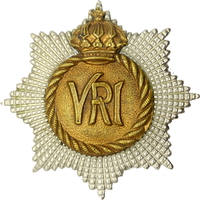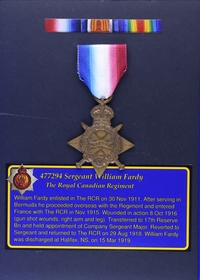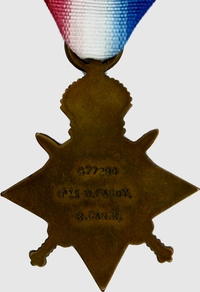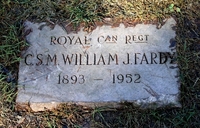
477294 Sgt William John Joseph Fardy
The Royal Canadian Regiment
By: Capt (ret'd) Michael M. O'Leary, CD, The RCR
On 30 Nov 1910, at Stanley Barracks in Toronto, Ontario, The Royal Canadian Regiment enlisted a new infantry recruit into the Canadian Permanent Force. William John Joseph Fardy had decided to try military service and would serve until the end of the Great War.
Hailing from Riverdale in Bruce County, Fardy's age at the time of his enlistment is noted as 19 years, 10 months. His birth date is unrecorded anywhere in his service records, but we can find him in the Canadian census of 1911, which recorded his birth month as October 1899 (his gravestone in Stratford, Ontario, says 1893). At five feet ten inches tall, he was described as having good physical development, no doubt a result of his employment as a labourer. Fardy was pronounced "Fit" by his medical examiner.
Fardy was given the regimental number 12009 and a few weeks later was sent to the Regimental Depot in Halifax. He arrived in that city on the 27th anniversary of the Regiment's birthday, 21 Dec 1910.
We find William Fardy appearing in the 1911 Canadian census as one of a long list of "lodgers" shown to be living in Wellington Barracks at the time of the census taking. Wellington Barracks was the main barracks for The Royal Canadian Regiment in Halifax before the First World War. The building, unfortunately, would be destroyed in the Halifax Explosion on 6 December 1917.
Tall and well built, William Fardy, like many young soldiers, must have imagined himself to be quite the ladies' man. But, his choice of companions were not always those of which his mother may have approved. On 25 May 1912, Fardy was admitted to Hospital at Halifax, N.S., with a diagnosis of gonorrhea. He would remain in hospital until 12 Jun 1912, though the effectiveness of his treatment may be doubted as there was no guaranteed cure until the antibiotic penicillin became widely used in the 1940s.
William Fardy was one of the Regiment's original soldiers that served in Bermuda From Aug 1914 to Aug 1915, replacing the British garrison there for the first year of the war. Fardy's proclivities for seeing the company of loose women had not, however, been cured in Halifax. On 10 Mar 1915, he was again admitted to hospital in Bermuda. This time he was diagnosed with syphilis and placed on the unit's Syphilis Register.
The requirements of the Syphilis Register are described in the 1914 edition of the Regulations for the Canadian Medical Service:
Syphilis Register.
The purpose of this register is to secure continued treatment for every case of syphilis, and to ensure that the courses of treatment are carried out in a definite and systematic manner.
The following rules will observed in keeping the register:-
1. Every case diagnosed "syphilis" will be entered in the register.
2. No name is to be removed until the patient has undergone a full course of treatment. Should any special reason arise to prevent this procedure being systematically carried out, the Assistant Director, Medical Service, will be informed and a full explanation given.
3. Transfers from other stations will be entered in red ink with a "T" in place of the serial number. The date of primary registration will be entered in the column of remarks; the information being obtained from the syphilis case sheet.
4. When a case, discharged to attend for treatment outside, requires re-admission on account of the occurrence of symptoms necessitating hospital care, a red ink "R" will be placed in the column of remarks, below which will be shown the date of re-admission, and later on the date of discharge. Should other re-admissions be required, a similar procedure will be followed in each instance.
5. Treatment should be continued for at least twelve months after the disappearance of active signs of the disease, and, if possible, that case should be kept under observation for a year after that.
Fardy was discharged from hospital on 6 Apr 1915. Although it was not in place at this time, soldiers in the Canadian Expeditionary Force serving overseas would later be subject to forfeiture of pay of 50 cents per day plus all field allowances for every day they spent in hospital for venereal diseases.
Three months after his discharge from hospital Fardy was examined at St George's, Bermuda, on 14 July and found fit for Field Service in preparation for the Regiment's relief at Bermuda before returning to Canada en route to Europe. Fardy attested for overseas service at Halifax on 22 Aug 1915, along with the remainder of The RCR before sailing for Europe. Initially serving in the CEF under their Permanent Force numbers, the Regiment would soon receive new CEF service numbers. Under the new numbering system, Fardy became 477294 Private William Fardy.
Having arrived in England, while at Shornecliffe, Fardy was charged and tried by the Commanding Officer on 22 Sep 1915, resulting in a comment in his service record describing what must have been a fine awarded as punishment for being AWOL: "2 days pay for absence from 6.00 a.m. 20 Sep 1915 until 1.00 a.m. 21 Sep 1915."
Fardy crossed over to France with the Regiment on 1 Nov 1915, debarking at Boulogne the same date. Throughout November and December of 1915 the Regiment prepared for service in the trenches, with companies rotating in the lines for training and a period of providing working parties before entering the line as a battalion at the end of December.
On 15 Jan 1916, William Fardy was promoted Sergeant in place of 477155 Sgt Carroll who was killed in action on 29 Nov 1915. Fardy's promotion would later be confirmed and backdated to the date of Carroll's death.
During May 1916, Fardy would be granted a period of nine days leave, which commenced on 15 May. While on leave, he received an extension one day, returning 25 May.
Fardy would be wounded in action on 9/10 Oct 1916. He was admitted to No. 5 British Red Cross Hospital, Wimereux, with gun shot wounds right arm and leg.
The regimental War Diary for 9 October reveals the intensity of the unit's actions over the preceding days (which is expanded upon in a related Appendix):
9-10-16. - TRENCHES.
Cloudy, not quite so cool. Total casualties reported to date are Captain SAPTE, Lieuts. SIMPSON, WALSH, SUTTON and PENNIMAN, Missing 8-10-16. Major HODSON, Major WOOD, Lieuts. DICKSON, DWYER, BELL and MURRAY, WOUNDED 8-10-16. Killed 7 other ranks. Missing 207 other ranks. Wounded 68 other ranks. It is expected that most of those reported missing will be located through slips from Casualty Clearing Stations as having passed through dressing stations of other regiments on our flanks.
Unfortunately, many of the missing soldiers would not be found in the dressing stations. Instead, a third of the number reported missing at the time would turn up on Prisoner of War lists. The RCR lost 69 of the 86 members of the Regiment taken prisoner during the Great War on 8 Oct 1916.
Wounded as he was, recovered from the battlefield and admitted to hospital, William Fardy was one of the lucky ones, destined for hospital in England rather than a POW camp in Germany or a battlefield grave. Evacuated on 11 Oct 1916, Fardy crossed the Channel on board the Hospital Ship St Denis, a ship taken into service from the Great Eastern Railway Company and capable of carrying 231 casualties.
At the time of his evacuation from France, Fardy was transferred to Canadian Casualty Assembly Centre (CCAC), Shoreham. The next day he was admitted to Bevan Military Hospital, Bathgate, England, with gun shot wounds in his right arm and leg. After 53 days in hospital w was discharged and transferred 4 Dec 1916 to the Canadian Convalescent Hospital, Monks Horton, Kent.
Fardy's medical case sheet prepared at Monks Horton, dated 4 Dec 1916, described his condition as "Shrapnel wound right arm, gunshot wound right leg, wounded Oct 8th; No. 14 Gen. Boulogne. Oct 12th went Bevan Military Bathgate, left for Monks Horton Dec 4th. Has had influenza at Bevan. Wounds healed." He was discharged to the CCAC on 2 Jan 1917 after 29 days at Monks Horton. Fardy went before a Medical Board on 3 Jan 1917 to assess his fitness for further service. Despite documented complaints of "pain below apex of heart", the board's recommendation was a medical category of "Aiii".
While serving in England, Fardy was attached to the 2nd Canadian Command Depot (2nd CCD) at Hastings. From this posting, he was reported absent as a deserter on 28 Jan 1917. The place of his "desertion or absence" was recorded as commending 26 January, 1917 at St Leonard on Sea, Hastings.
Fardy remained on the lam for over five weeks and apprehended and arrested on 7 Mar 1917 by Constable Francis Cutts, at Swadlincote. The police report noted that "Const. Cutts visited the residence of William Brealey, Woodhouse Street, Swadlincote, and there saw prisoner, he asked him for his pass and on it being rendered found that it expired at 12 m.n. 25th January, 1917. He arrested Fardy and conveyed him to Woodville Lockup".
Returned to the proper military authorities, Sergeant Fardy would be tried by Cort Martial for his absence and, accordingly, on 29 Mar 1917 the Commanding Officer of 2nd CCD applied to Commander Canadian Troops, Hastings, for the latter to sanction an order that a District Court Martial be assembled to try Sgt Fardy for absenting himself without leave.
On 5 Apr 1917 Lieut. Colonel H.H. Matthews, D.S.O., Commanding Canadian Troops (Hastings) signed the Form of Order authorizing the assembly of a General or District Court Martial to try Fardy. The District Court Martial (DCM) would be conducted on 10 Apr 1917. The President of the Court would be Major Alexander Cameron Grant (Attached H.Q. Hastings), a barrister-at-law from Edmonton Alberta who has joined the 151st Overseas Battalion in 1915. The members of the court were Capt William W. Muir (CGDD) and Capt Sydney Hugh Bridgman Grasett (CGDD). Lieut. J.M. Chisholm (2nd CCD) would act as the Prosecutor and Capt C.S. Carter as counsel for the accused.
The charge sheet, prepared and dated 5 Apr 1917, read as follows:
"The accused, No. 477294 Sergeant William John Fardy, R.C.R., Canadian Expeditionary Force, attached to Second Canadian Command Depot, Hastings, a soldier of a force raised in a colony and doing duty with the regular forces within the United Kingdom, is charged with,
First Charge A.A. Sec 15 (1a) While on active service, absenting himself without leave, in that he overstayed his leave from the Canadian Command Depot, Hastings, from the twenty fifth day of January, 1917, until apprehended by the Civil Power at Swadlincote on the seventh day March, 1917."
Fardy's Court Martial took place on 10 Apr 1917. The first witness for the prosecution was Lieut Felix Bolte (5th CMR attached 2nd CCD), who stated: "On January 28th, 1917, I was attached to the C.C.D. and was authorized by the Commanding Officer to sign on his behalf "Reports of Deserters". The form A.F.B. 124, exhibit "A", was produced and the signature upon it was confirmed by Lieut Bolte to be his own.
Throughout the brief proceedings of the Court Martial, Fardy declined to call any witnesses on his own behalf, or to make any statement. He also stated that he was "Not Guilty" of the charge laid against him.
It was noted at during Fardy's court martial that by the time of the trial he has already been in cells for 34 days. The trial record also noted that he had 1 year, 8 months CEF service and 4 years, 9 months service before the war with The Royal Canadian Regiment, and that he had been promoted in the field on 29 Nov 1915. Fardy had no Conduct Sheet presented, a Statement to Character and Particulars of the Accused noted that his original Conduct Sheet had been "destroyed at Willebeke" on 2 June 1916 during an attack by the Germans on the 7th Brigade's positions. Fardy's Court Martial record also contains a blank conduct sheet which noted the destruction of the original and it was provided as a certified true copy, signed off by the O.C. "D" Company, The R.C.R.
After hearing evidence against Sergeant Fardy and available information on the accused's character, the president of the Court Martial adjourned proceedings for one day. The adjournment allowed the President to inquire with O.C. Troops, Hastings, on a the matter of how the Court should consider the time already spent in confinement by the accused. In particular, the President's letter notes the period between Fardy's arrest on 7 March and the application of Court Martial being submitted three weeks later, on the 29th of that month.
Fardy's Court Martial resumed at 2 p.m. on 11 Apr 1917. The Court found that 477294 Sgt Fardy, W.J., R.C.R., attached 2nd C.C.D., was "GUILTY of the charge as laid." He was sentenced to be reduced to the permanent grade of Corporal. The sentence was confirmed by O.C. Troops, Hastings, on 14 Apr 1917.
Following his Court Martial, Corporal Fardy was taken off strength of the 26th Reserve Battalion and sent on command to the 2nd Canadian Command Depot (C.C.D.) from 15 May until 13 Jul 1917. On that date he ceased to be on command 2nd CCD and was struck off strength of the NSRD to join the 26th Reserve Battalion at Bramshott. later, on 15 Oct 1917, Fardy was taken on the strength of the 17th Res Bn from the 26th Res Bn.
Although he had been reduced in his permanent rank by the Court Martial, William Fardy was appointed Acting Company Sergeant Major (CSM), with pay, in the 17th Reserve Battalion at Bramshott on 1 Dec 1917. Shortly thereafter, on 5 Dec 1917, Fardy's pay account was adjusted, and a forfeiture of pay as a result of his Court Martial was canceled, restoring $69.60 to his pay account, the difference between a Corporal's and Sergeant's pay during the period from 13 Apr to 30 Nov 1917.
Continuing to serve with the 17th Reserve Battalion, Fardy was sent On Command to the Drill and General Course, conducted at Chelsea, On 17 Jun 1918. He returned to the the 17th Reserve Battalion on 12 Jul 1918.
Most likely dissatisfied with base and training duties in England, Fardy reverted from his appointment of Acting CSM to his permanent rank of Sergeant on 29 Aug 1918 at his own request in order to proceed overseas. He was taken on strength of The RCR and proceeded overseas to France effective the same date and on 5 Sep 1918 was despatched from the CCRC to rejoin The RCR. Fardy rejoined The RCR in the field on 8 Sep 1918 and remained with the Regiment until after the Armistice.
Fardy proceeded to England on 06 Feb 1919 and was identified for Sailing List No. 25 for 1 Mar 1919. He was Struck off the Strength of the Canadian Expeditionary Force Overseas on return to Canada on that date and embarked aboard the S.S. Adriatic at Liverpool for return to Canada.
Arriving in Canada, William Fardy was taken on strength of No. 6 District Depot on 9 Mar 1919 from overseas and subsequently struck off strength to the Base Depot, The R.C.R. Less than a week later, on 15 Mar 1919, Sergeant William John Joseph Fardy is discharged from the Canadian Expeditionary Force on demobilization. His intended place of residence was Halifax, NS, and he was authorized to wear a Class "A" War Service Badge, being issued badge number 77341.
Fardy's rate of pay in the CEF ranged from $1.00 per day as a Private soldier, to $1.10 as a Corporal to $1.35 as a Sergeant to a maximum of $1.50 per day while he was being paid as an Acting Company Sergeant Major. He also received a daily field allowance of 10 cents per day as a private and Corporal, which increased to 15 cents daily when he held the rank of Sergeant. A single man, Fardy never assigned anyone as a recipient of assigned pay, choosing instead to have his pay accumulate in his pay records. By February 1919, his pay account was showing him to be owed $803.94. He was also entitled to a War Service Gratuity after the war, which was calculated to be $420. Fardy received his gratuity in monthly installments of $70 between April and September 1919.
Fardy's medals would be sent to him in February of 1921. He would receive a First World War trio, consisting of the 1914-15 Star, British War Medal and Victory Medal.
In June of 1950, William Fardy's address was recorded as 136 Regent St, Stratford, Ontario. William Fardy died in 1952. He is buried in the Avondale Cemetery in that town, under a simple flat gravestone reading "Royal Can. Regt., C.S.M. William J. Fardy, 1893 - 1952."
Pro Patria
Visit a randomly selected page in The O'Leary Collection (or reload for another choice):
- The O'Leary Collection; Medals of The Royal Canadian Regiment.
- Researching Canadian Soldiers of the First World War
- Researching The Royal Canadian Regiment
- The RCR in the First World War
- Badges of The RCR
- The Senior Subaltern
- The Minute Book (blog)
- Rogue Papers
- Tactical Primers
- The Regimental Library
- Battle Honours
- Perpetuation of the CEF
- A Miscellany
- Quotes
- The Frontenac Times
- Site Map
QUICK LINKS
The O'Leary Collection—Medals of The Royal Canadian Regiment
Newest additions:
![]()
![]() SB-12725 Private Henry "Hank" Ard
SB-12725 Private Henry "Hank" Ard ![]()
WIA at Hill 187, Died of Wounds in Japan
![]()
![]() 2355331 Lance Corporal Albert Lorking
2355331 Lance Corporal Albert Lorking
Wounded in action, later a War Amps representative.
![]()
![]() 4334 / 477996 Pte Isaac Hamilton Wilcox
4334 / 477996 Pte Isaac Hamilton Wilcox
Permanent Force, South Africa, and C.E.F.
![]()
![]() 477019 Private Harold Ashcroft
477019 Private Harold Ashcroft
Transferred to the Tunnelers.
![]()
![]() 734231 Private Clark D. Thompson
734231 Private Clark D. Thompson ![]()
The older Thompson brother, killed in action.
![]()
![]() 733849 Private Norman Parker Thompson
733849 Private Norman Parker Thompson
The younger Thompson brother; post-war service in the Special Guard.
![]()
![]()
![]() A305 / 400305 Private Andrew Walker
A305 / 400305 Private Andrew Walker ![]()
"Previously reported Wounded, now Killed in Action."
![]()
![]() 823298 Pte Thomas Patrick Steele, M.M.
823298 Pte Thomas Patrick Steele, M.M. ![]()
… for gallant conduct in the field …
![]()
![]() P13066 Sergeant Harold Thompson
P13066 Sergeant Harold Thompson
Instrumental Soloist for over 20 years of Canadian Army service.
![]()
![]() 9609 / 477728 Private Albert Edward Piper
9609 / 477728 Private Albert Edward Piper
"Arrived from England as a STOWAWAY …"




